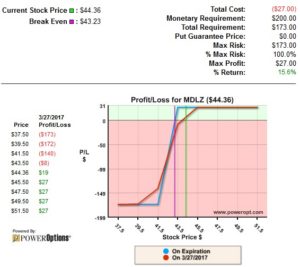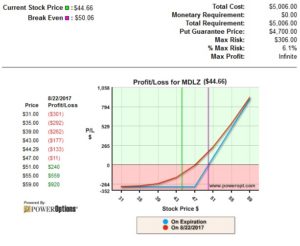We have posted articles and held webinars about this topic before, but it is a common misconception about our Married Put – RadioActive Trading approach.
Many options investors evaluating the RadioActive Technique come from a background of Covered Call investing, selling Cash Secured Naked Puts, trading Credit Spreads or other combination plays.
With these strategies investors ‘generate’ an option premium or a credit up front for income. Most of these strategies are traded using options that expire one month out, or less.
This allows them to calculate:
- A % if assigned or % return in the best case scenario
- A % downside protection – how far the stock can move before the investor loses money on the position at expiration. Monetarily, this is the break-even
- Using tools like PowerOptions, a theoretical probability of success
It is the second point that usually brings up the concern of being -10% or more ‘In the Hole’ or ‘Underwater’ when they first see a RadioActive Trade. But, that is not the case…
Let’s look at a covered call. The other day we opened a RadioActive Trade on Mondelez (MDLZ) for our Fusion subscribers. At the time the stock was trading at $44.66. We will look at that position in a moment…
But, at the same time, an investor could have opened a Covered Call as:
Covered Call: 3/16/2017
Buy 100 shares MDLZ at $44.66
Sell to Open 1 31-MAR 45 call at -$ 0.65 (15 days out in time)
Total Out of Pocket / Break Even= $44.01
Maximum Risk = $44.01, or 100% (of investment if stock goes to $0.00)
Max. Return / % if Assigned = 2.2% (if the stock is above $45.00 in 15 days. This includes the $0.65 premium and capital gain from the stock purchase to the strike price)
% Downside Protection = 1.5% (how far the stock can fall before we lose money on the trade)
We know up front that our maximum return, the best case scenario, is $99.00 of profit or 2.2% – if MDLZ is above $45.00 on March 31st.
We also know that we will lose money on this covered call if MDLZ is below the break-even of $44.01 on March 31, our cost basis for the covered call, and we could lose a lot of money if the stock falls -10%, -15% or more with this setup.
But, we know the break-even up front, and that we need the stock to be above $44.01 on March 31st to make any profit.
Bull Put Credit Spread: 3/16/2017
Let’s say you were bullish on MDLZ but you wanted to use a leveraged spread trade. You could have opened a short term Bull Put Credit spread as:
Sell to Open 31-MAR 43.50 put at -$0.38
Buy to Open 31-MAR 41.50 put at $0.11
Total Net Credit/Max. Profit = -$0.27, or 15.6%
Max. Risk = $1.73, or 100% (margin required to place the trade)
Probability Above $43.50 = 74.6%
Break Even at Expiration = $43.23
Risk:Reward Ratio = appx. 6.5:1 (Max. Loss / Max. Profit = $1.73/$0.27 = 6.41)
Again, we know up front that our goal is to earn the maximum return of 15.6%, if MDLZ remains above $43.50 on March 31st. Both puts would expire worthless and we would keep the net credit of $0.27.
We also know that we will lose money on this credit spread if MDLZ is below the break-even of $43.23 on March 31, and the maximum loss of -$1.73 would occur if the stock was below $41.50. This would be more than 6 times the maximum potential profit… one full loss would wipe out 6 or more previous positions’ gains.
And again, we know the break-even point up front, which may be a target price for adjusting the position to minimize loss.
Limited Risk – RadioActive Trade
So, here is the position we opened on MDLZ for our Fusion Subscribers on 3/16/2017:
Buy 100 shares of MDLZ at $44.66
Buy 1 2018-JAN 47 put at $ 5.40 (309 days to expiration)
Total Invested = $50.06
Guaranteed Exit = -$47.00
Maximum Risk = $ 3.06, or 6.1%
Maximum Profit = Unlimited (important since we are bullish on MDLZ)
This is a different structure, but still a bullish position. There is no calculated maximum return, as the upside is unlimited.
The maximum risk is $3.06, which is higher than the Bull Put spread, but that monetary loss represents only 6% of what we have invested in the position – not 100% of the investment as it is with the Bull Put spread. And, that maximum loss is likely only to be realized at expiration, which is over 300 days away.
Which brings us to the break-even. Of the 3 positions the RadioActive Married Put is the only one where the break-even is increased. We now see a break-even of $50.06, which is 12% higher than the current stock price. Here is where the questions come in:
Why add cost to the position? You are not going to make a dime until the stock goes above $50.06?
Answer: Correct… if and only if we held MDLZ all the way to January 2018 expiration, made no adjustments to the position and accepted no dividends. If we held the position all the way to January expiration and made no adjustments, we would still collect $0.76 in dividends knocking the maximum risk down to $2.30. This is less of a monetary risk than doing 2 contracts of the Bull Put Spread. Also, this is a positive Delta position – if the stock moves up $1.00 in the first month, we may only lose -$0.50 on the protective put. The position would be at a profit. The break-even for the far term position is only relevant at expiration.
So, the real answer is no. I could make a dime on this position if the stock moves up $0.20 or $0.25 in the first week or two. But, our goals are higher.
But you paid $5.40 for the put… you are already underwater by 12% when you open the position!?!
Answer: Nope. Yes, paying $5.40 for a protective put on a stock trading at $44.66 seems expensive. But, we bought an In-The-Money $47.00 strike put. This means that $2.34 of that $5.40 cost is intrinsic value, and we are guaranteed to get that back. The true risk on the position is only the extrinsic, or time value, on the position. This is why the maximum risk is only $3.06.
Okay, so you are $3.06 underwater or behind the 8-ball, and will need the stock to move up $3.16 to make a dime!?!
Answer: Again, nope. The worst case scenario is a loss of $3.06 – if and only if:
- We hold the position all the way to 2018-January Expiration and…
- MDLZ is trading below $47.00 per share and…
- We make no adjustments on the position and accept no dividends over the 300+ days
That is the only time we would likely realize the full loss of $3.06 – or need the stock to be trading above $50.06 to make a profit. And that is not the plan.
But, let’s us consider something else: Are we $5.40 or even $3.06 underwater when we open the position? No. The put is not simply just insurance. It is a working asset that we purchased. The put does not go to $0.00 when we enter the trade. In fact, all we are losing – or are ‘behind’ – in the trade when we open a RadioActive Married Put is the bid-ask spread of the put option.
At the close on March 16th when this position was opened we see a liquidation value of:
Sell to Close 100 shares of MDLZ at $44.88 (up $0.22 from purchase)
Sell to Close 2018-JAN 47 put at $ 5.30 (down only -$0.10 from purchase)
Total Liquidation Value = $50.18
Total Cost to enter trade = -$50.06
Profit after 1 day of trade = $ 0.12, or 0.2%
Oh, so we could have made 0.2% in one day. Wheee! Of course that is not our goal. But, hey! Look at the profit. We could have made more than a dime on the position and the stock is at $44.88 – still nowhere near the ‘break-even’ of $50.06.
Okay, but the other two trades generate income, lower the cost (break-even) and are shorter term trades. They will give a better profit over time!?!
Answer: Let’s look at that, shall we. When we open a RadioActive Married Put we have the expectation that the stock could move up 3-8% in the next 20-40 days. Let’s say we saw a 5% gain (+$2.23) in the first 15 days- on March 31st expiration. MDLZ would close at $46.89. Of our 3 positions:
- Covered Call – We would be assigned at $45 and make a $0.99 profit, or 2.2%
- Bull Put Credit – The puts would expire worthless and we would keep the profit of $0.27, or 15.6%
- RadioActive Married Put – We would have a gain of $2.23 on the stock, but a loss of only -$1.20 on the put (using Black-Scholes pricing model). This would be a profit of $1.03, or 2.1%
Huh…seems as though if our expectations were met the ‘extra cost’ RadioActive Married Put would have the highest monetary gain. Of course, the Bull Put has the highest % gain due to leverage.
Which brings us to the other side. What if we were wrong, and the stock fell -5%, or -$2.23, in the first 15 days?
- Covered Call – The 45 strike call would expire worthless. If liquidated, the covered call would have a loss of -$1.58, or -3.6% of the investment.
- Bull Put Spread – The long 41.50 put would expire worthless. We would have to take assignment of the stock, or buy to close the 43.50 short put for a cost of about -$1.07. This is not the maximum loss, but is close to 5 times higher than the expected profit. In other words, we may have erased the gains of close to 5 previous spreads with this strategy. And in terms of leverage, a loss of -$1.07 represents a loss of -62% of the investment, or margin for the spread. Yikes.
- RadioActive Married Put – We would have an unrealized loss of -$2.23 on the stock. But, we would have a gain on the put around $1.25 (put would be priced at about $6.65). If we liquidated the position we would have a loss of only -$0.98, or -1.9% of our investment.
So… are the shorter term trades which generate income and lower the break-even better trades?
Not in this example. The RadioActive Married Put had a higher monetary (but lower) percentage gain if our expectations were right. If we were wrong, the RadioActive Married Put would have a lower monetary and percentage loss compared to the other two strategies.
This is why we advocate this strategy, and why we trade it in our personal accounts.
Maybe you feel a 5% swing in 15 days is a bit extreme. But, I will leave you with this:
- We already showed how the protective put does not put you behind the 8-ball when the position is opened, and the ‘break-even’ on a RadioActive Trade due to the cost of the put is only relevant at expiration – several months out in time.
- We showed how the RadioActive Married Put could earn more than these income strategies with a 5% increase, and lose less than those strategies with a -5% decrease.
- Long-term portfolio effects:
- If your covered call trading plan is to make 2% every 14 days or so, you saw how a -5% decrease would result in a loss of -3.6%. This loss, though small, would take out almost 2 previous wins. Think about the math on that…you would need to be right over 65% of the time to profit long term. And it would not be that big of a profit.
- If your Bull Put trading plan is to make 15% leveraged gain, with a 75% probability of success, you are likely opening positions that have a 6:1 or 7:1 risk:reward ratio. This means you need to be right closer to 85% of the time to profit long-term. Again, yikes.
- If you control risk and make only 2.1% on winners, and lose only -1.9% on the losers, you can actually be wrong more often than right and still make money. As I mentioned our profit goals are higher, and achievable, for each position, and at times we can actually cancel the risk on our RadioActive Trades.
Have you seen the success rate you have hoped for with the Covered Call Strategy? Is your portfolio full of stocks that have gone down so that writing new calls at the lower strike price have the danger of being assigned for a loss?
Have you seen successful trades on credit spreads, only to watch your portfolio lose value over time even with a success rate of 70% or higher?
Maybe it is time to consider a different trading strategy, and see how the RadioActive Trading techniques can enhance your portfolio.



 I'm Kurt Frankenberg, and I have discovered how to truly put the odds on the side on the individual investor.
I'm Kurt Frankenberg, and I have discovered how to truly put the odds on the side on the individual investor.
Now, add an short 30 delta call to the radioactive married put and when the short 30 delta call strike price is breached add a long call BELOW the short call strike to the short call to keep the possibility for unlimited profit and if the stock price reverse sell the long call for an tiny loss or for a scratch and repeat this all the way the long put duration AND COLLECT ALL THE WAY DIVIDENDS, and adjust your long put all the way ‘up’ if the stock price increase, you could perhaps have a winning strategy 🙂
In summary:
Stock tank ->you reduce your cost basis
Stock goes north -> you keep unlimited profit
Life is beautiful 🙂
Hi Mike,
how do you not lose the “intrinsic” value of the put if the stock goes down and at expiration
you get the stock “PUT” to you. You lose the entire amount you paid for the put at expiration, no?
Thanks for all your videos and teaching. I do enjoy them.
GLenn
I hesitate to comment as it will likely expose my ignorance but here it goes. My first more lengthy attempt was lost with an inadvertent key stroke so this attempt will be concise.
The time period for the married put strategy is 309 days and 15 days for the covered call and spread plays. I see that you address that in your final point too. Circumstances would not allow for 20 repetitions of the covered call and spread strategies but it might be reasonable to repeat those at least 7-8 times in 309 days thus allowing for some loss but still overall profitable strategy. The assumption of a full loss on 1 or 2 trades also ignores the potential for adjustments that could and should be made to avoid the full $1,743 loss on any of the spread transactions.
Here’s where I probably get really stupid. The married put requires that I devote $50,000 from my account not counting or crediting the follow up put and call trades you describe. The put spread requires that I allocate either $2,000 or maybe $1,743. If suitably reckless could I not enter into 25 put spreads with $2 strike spreads (or 10 at $5 strike difference) for the same $50,000 requirement for the married put? So rather than 1 married put play for 309 days couldn’t the same capital requirement support multiple spreads multiple times during the same period. (I think you may have mentioned not intending to be in the married put for the full 309 days but I have no way to know how long would be typical)
I know that this ignores your often repeated well reasoned caution that one failed spread can wipe out 5 or 6 successful ones. A 100% failure should be more rare given that in most cases adjustments can be made if properly monitored thus improving the ratio of successful spreads.
As a new subscriber to PowerOptions I have to say that the PowerOptions and associated sites are the most useful I have found and the only one that I have been willing to pay for over 3 years or so of becoming a more manager of our investments. Thank you.